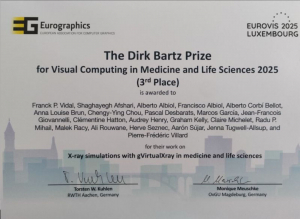A research team from IFIC awarded at Eurovis 2025 for their radiographic simulation platform gVirtualXray
The paper X-ray simulations with gVirtualXray in medicine and life sciences, developed by researchers Francisco Albiol, member of the Instituto de Física Corpuscular (IFIC, a joint center of CSIC and the Universitat de València), Alberto Albiol, researcher at the Universitat Politècnica de València, and Alberto Corbi, who completed his PhD at IFIC, has been awarded the third Dirk Bartz Prize 2025 at the prestigious Eurovis Conference, organized by the Eurographics Association (EA).
The prize recognizes significant advances in the field of computational visualization applied to medicine and life sciences. In this case, the jury particularly praised the open, versatile, and innovative approach of the gVirtualXray (gVXR) tool, an open-source platform that enables real-time simulation of X-ray projections using GPU technology and high-performance rasterization algorithms.
One of gVXR's key strengths is its validation against Monte Carlo simulations, a method widely used in medical physics to precisely model the behavior of X-rays as they pass through different tissues. These simulations rely on random numbers to mimic millions of possible particle trajectories, offering highly reliable results but with high computational cost. The awarded tool strikes a balance between realism and efficiency, making it especially valuable in scenarios requiring fast and interactive responses.
Beyond its precision, gVXR has proven effective both in educational environments and in advanced medical physics applications, allowing students and professionals to explore complex clinical scenarios in realistic and interactive virtual environments.
Key outcomes of the project include: international collaborations with academic and clinical centers for validation and application of the system; the development of immersive virtual reality teaching tools for radiological techniques; the publication of scientific articles and several patents related to simulation-based densitometric imaging and its clinical use; and technology transfer to applied innovation projects, including collaboration with the Instituto de Biomecánica de Valencia (IBV) on environmental recognition systems for particle detectors, leveraging gVXR’s capabilities as a synthetic X-ray projection generator.“I believe it’s important to strengthen our sense of community and support initiatives like gVirtualXray, which help us move forward and share knowledge. I hope that next time we can better coordinate these efforts to fully seize the communication opportunity, especially knowing that many of our researchers use these tools daily and that this is an additional way to gain visibility,” says researcher Francisco Albiol.
This international recognition highlights not only the scientific and technical quality of the work, but also its cross-sector impact in areas such as medical physics, higher education, clinical simulation, and data science for medical imaging.
Explore examples of real-world applications currently under development by this community of researchers, who have been among the first to use the system for transfer-oriented research:
https://gvirtualxray.sourceforge.io/applications/




















